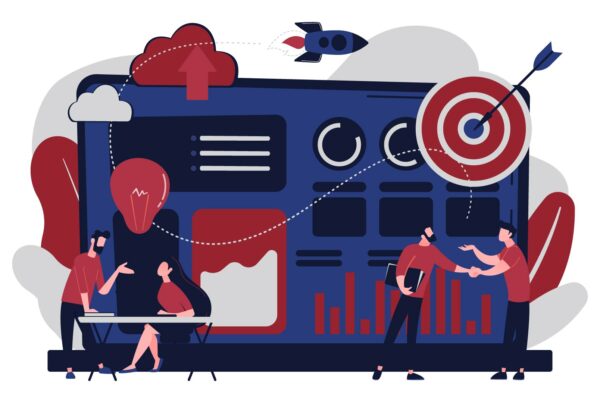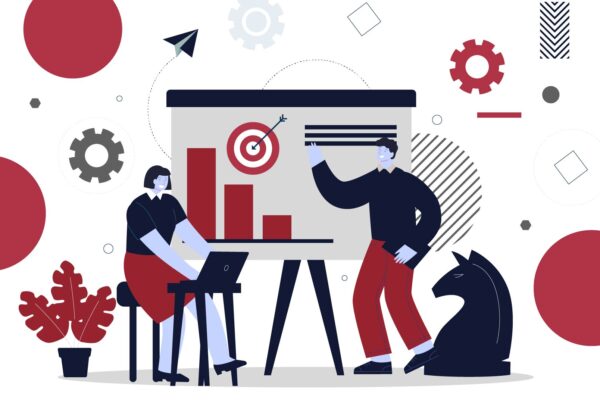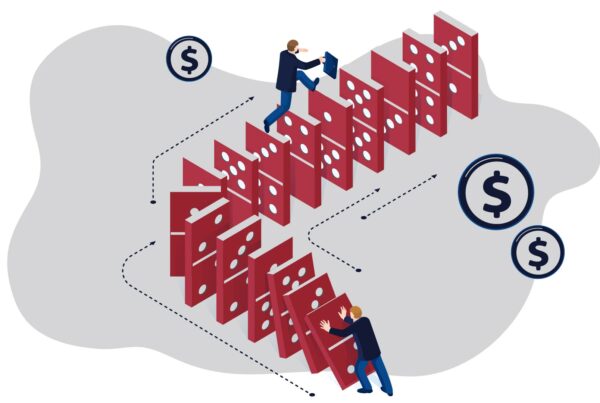This blog was originally published on LinkedIn.
In the quest for predictable growth and measurable marketing ROI, many CEOs focus their marketing investments primarily on late-stage conversion activities. While this approach may yield short-term results, it creates a dangerous blind spot that can stall growth and leave your company vulnerable to more strategic competitors.
As you evaluate your marketing investments with your marketing leader or agency partner, understanding the full revenue impact of each customer journey stage becomes critical. Here’s why investing across the entire journey isn’t just a marketing best practice—it’s a strategic imperative for sustainable growth.
The customer journey is a comprehensive framework that mirrors the buyer’s path, illustrating the stages a prospect goes through before becoming a loyal customer. It typically comprises four key stages:
- Awareness: At the initial stage of the journey, businesses strive to create brand awareness and capture the attention of potential customers. Strategies include content marketing, social media engagement, and SEO.
- Consideration: In this stage, prospects are actively exploring solutions to their problems. Companies must provide valuable content, engage in thought leadership, and demonstrate their expertise to be considered a viable option.
- Conversion: The middle of the journey is where leads transition into customers. Convincing prospects to make a purchase is the primary goal, and it involves effective nurturing and compelling offers.
- Post-purchase: Once converted, customers enter the post-purchase stage. Here, the focus shifts to delivering exceptional customer experiences, maintaining relationships, and encouraging repeat business and referrals.
The Criticality of Investing at Each Stage of the Customer Journey
All too often, companies make the mistake of investing only in the consideration stage when prospects have a high intent to make a purchase. I get it. That’s low-hanging fruit. But this strategy misses all the opportunities further up the funnel and limits your ability to scale. It’s short-sighted.
As a B2B marketing leader or CEO, you must battle this thinking. Each stage of the customer journey requires an investment to build a marketing engine that truly scales your company to its fullest potential.
The customer journey represents the lifeline of a company’s relationship with its clientele. Neglecting any of these crucial stages leaves opportunities for growth, customer satisfaction, and business sustainability untapped.
Why Invest at the Awareness Stage?
Building a strong foundation: Investing in the awareness stage sets the foundation for long-term success. Building brand awareness ensures that your company is on the radar of potential customers, making it more likely that they will consider your offerings when the need arises. An effective awareness strategy establishes your brand as an industry authority, instilling trust and credibility.
Capturing a wider audience: The awareness stage allows you to reach a broad audience, including those who might not have an immediate need for your products or services. By casting a wider net, you create opportunities to nurture prospects over time, ensuring that your brand remains top of mind when they’re ready to make a purchasing decision.
Generating demand: Investment in awareness often involves content marketing, which educates your audience about industry trends, challenges, and potential solutions. As a result, you create demand for your products or services, even among those who weren’t initially aware of their need for them.
Feeding the journey: The awareness stage serves as the journey’s entry point. It’s the source of leads that will move through the subsequent stages. Without a continuous investment in generating awareness, the journey can stagnate, impeding growth and revenue generation.
Why Invest at the Consideration Stage?
Guiding the decision-making process: The consideration stage is where prospects actively research and compare solutions. Investing in this stage allows you to influence their decision-making process. Providing high-quality, informative content positions your company as a trusted advisor and helps prospects navigate their options. Email, influencer, and customer review strategies are common in this stage.
Qualifying leads: By nurturing prospects in the consideration stage, you qualify leads effectively. Not all leads are equal, and dedicating resources to this stage enables you to identify which prospects are most likely to convert. This, in turn, optimizes your sales efforts and enhances efficiency.
Creating a competitive advantage: Competitors are vying for the attention of the same prospects. Investing in consideration-stage marketing gives you a competitive advantage by showcasing your unique value propositions and differentiating your offerings.
Building relationships: The consideration stage is an opportunity to build relationships with potential customers. Engaging with them, addressing their pain points, and providing valuable insights fosters trust and goodwill that extends into the conversion and retention stages.
Why Invest at the Conversion Stage?
Turning leads into revenue: The goal of any marketing effort is to generate revenue. The conversion stage is where leads become paying customers. Investing in this stage ensures that your marketing efforts translate into tangible business outcomes.
Shortening sales cycles: Investment at the conversion stage streamlines the sales process. By providing prospects with compelling offers, clear calls to action, personalized experiences, product or service guarantees, a simplified check-out process, and responsive support, you reduce the time it takes for them to decide. Abandoned cart recovery and retargeting strategies are also common in this stage.
Demonstrating MROI: Measuring MROI becomes more straightforward when resources are dedicated to the conversion stage. Marketing leaders and CEOs can clearly track the impact of their marketing investments in terms of customer acquisition, revenue, and profitability.
Maintaining continuity: The conversion stage marks the transition from prospect to customer. Investing here is crucial for maintaining continuity in engagement and ensuring that the customer’s experience is seamless and positive from initial contact through to the purchase.
Why Invest at the Post-Purchase Stage?
Maximizing customer LTV: Retaining existing customers is usually far more cost-effective than acquiring new ones. Investing in the post-purchase stage focuses on delivering exceptional customer experiences, which leads to repeat business, upselling, and cross- selling opportunities.
Building brand advocacy: Satisfied customers become advocates for your brand, recommending your products or services to others. Investment in the post-purchase stage turns customers into loyal brand advocates, contributing to organic growth.
Reducing churn: Customer retention efforts aim to reduce churn rates, which are a significant drain on resources. Retaining customers through ongoing engagement, support, and value-added services lowers churn and stabilizes revenue streams.
Driving improvements: Investment in the post-purchase stage often involves data analysis and feedback collection. This information is invaluable for identifying areas for improvement, enhancing product offerings, and refining marketing strategies based on real customer insights.
In essence, a marketing leader’s or CEO’s commitment to investing at every stage of the customer journey is a strategic choice that drives growth, fosters customer satisfaction, and, ultimately, secures the future prosperity of the business.
It All Matters
The path to predictable growth and stronger marketing ROI lies in strategic investment across every stage of the customer journey. While some stages may not offer easily measurable returns in isolation, they’re crucial components of a high-performing revenue engine.
For CEOs with an eye on optimizing their marketing performance, the key is partnering with your marketing leaders to ensure that measurable returns from high-conversion activities more than offset investments in brand building and awareness. This balanced approach doesn’t just drive immediate results—it builds the foundation for sustainable, predictable growth that shareholders and boards demand.
Sign Up for Our Free Weekly Newsletter
Get more battle-tested marketing tips delivered straight to your inbox every Thursday.
By Lori Turner-Wilson, RedRover CEO/Founder, Internationally Best-Selling Author of The B2B Marketing RevolutionTM: A Battle Plan for Guaranteed Outcomes
Taking Action
Investing at every stage of the customer journey is one of hundreds of best practices found in The B2B Marketing RevolutionTM: A Battle Plan for Guaranteed Outcomes — the playbook that middle-market B2B CEOs and marketing leaders lean on to scale. Backed by a groundbreaking research study, this book offers time-tested best practices, indispensable KPIs for benchmarking, insights on where your dollars are best spent, and, above all, the proven 12 BattlesTM Framework for generating guaranteed marketing outcomes. The B2B Marketing RevolutionTM is a battle-hardened approach to becoming an outcomes-first leader who’s ready to shake up the status quo, invest in high-payoff market research and optimization, and — yes — even torch what’s not serving your endgame. Download more than 50 templates, scripts and tools from the book on the Battle Reader Hub.
If you’d like to talk about how to build a marketing engine that delivers predictable results — whether you want to build it yourself or tag in our team to lead the way — we’d be delighted to help you get started.







